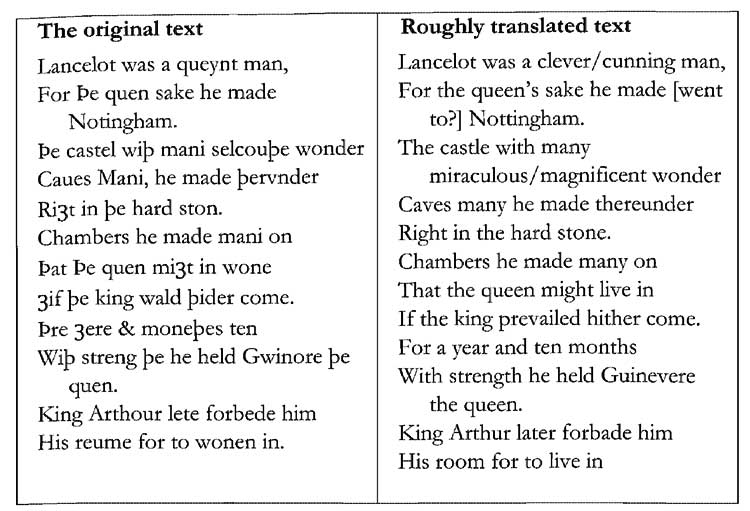Articles from the Thoroton Society Newsletter
The caves of Nottingham Castle in Arthurian legend: A glimpse from the Auchinleck Manuscript
By Scott C. Lomax
How did real events at Nottingham Castle inspire an Arthurian legend, and what can the legend teach us about the castle, and the use of its caves almost 700 years ago?
The Auchinleck Manuscript, a fascinating document written in London around the year 1340, is a treasure trove of historical and legendary stories. It consists of 43 pieces of literature, all written in Middle English, and is believed to have been written by lay scribes rather than monks.
One particular passage in this manuscript provides a fascinating connection to Nottingham Castle, intertwining fact and fiction.
The manuscript features tales of King Arthur, one of which relates to Sir Lancelot and Queen Guinevere’s infamous affair. In this retelling, Lancelot, ever the clever and resourceful knight, is said to have taken Guinevere to Nottingham, where they hid in caves beneath the castle.

This portion of the manuscript, though steeped in myth, offers an insight into the castle’s subterranean spaces and their association with real events. Importantly it indicates that Nottingham had a castle of 'many miraculous/magnificent wonder’. While this phrase could be interpreted in various ways, it may refer to the caves hewn into the castle rock. If so, this suggests the castle caves may have a feature well-known outside of Nottingham.
What makes this passage especially interesting is its historical timing.
The Auchinleck Manuscript was written only a small number of years after the dramatic events surrounding the capture of Roger Mortimer, the Earl of March, who, with Queen Isabella (wife of Edward II and mother of Edward III) effectively ruled the Kingdom during Edward Ill’s minority. The manuscript’s description of secretive chambers in the castle’s caves is likely to have been inspired by the true story of Mortimer’s capture by Edward Ill’s men, who entered the castle via the winding passages carved into the rock, using a cavernous tunnel located on the western side of the Castle Rock rather than the cave known today as Mortimer’s Hole.
It is possible that the tales of Lancelot and Guinevere’s hideaway in the Nottingham caves reflect misconceptions about Mortimer’s alleged inhabiting of the castle’s caves, and perhaps even further fuelled such misconceptions. Some medieval accounts describe Mortimer as having hidden in the caves beneath the castle, just as Lancelot and Guinevere allegedly did. Although John Leland, who visited Nottingham in c1540, did not mention Mortimer and his association with the Castle’s caves, William Camden writing a few decades later noted: ‘In the upper part of the castle which stands very high upon the rock, I likewise went down many stairs into another vault under-ground; which they call Mortimer's Hole, because Roger Mortimer absconded in it, being afraid of himself, out of a consciousness of his own guilt.’ Daniel Defoe visited the castle during the early 18th century but was too afraid to enter one of the caves. Nonetheless, in one of his writings he made reference to Camden’s claim and suggested that it was still widely believed by people in Nottingham, though Defoe himself debunked the claim.
Defoe was most likely correct to debunk the myth that Mortimer’s Hole was so named because Mortimer had sought refuge there. It is likely that the cave known as Mortimer’s Hole was in fact used as the means by which the disgraced Earl was taken out of the castle.
For those interested in exploring more of the Auchinleck Manuscript and its depiction of Nottingham’s legendary past, the full text is available online at the National Library of Scotland’s website (https://auchinleck.nls.uk). The tale of Lancelot and Guinevere, set within the caves beneath Nottingham Castle, offers a fascinating glimpse into how medieval writers intertwined history, contemporary events, and myth to craft unforgettable stories.
< Previous